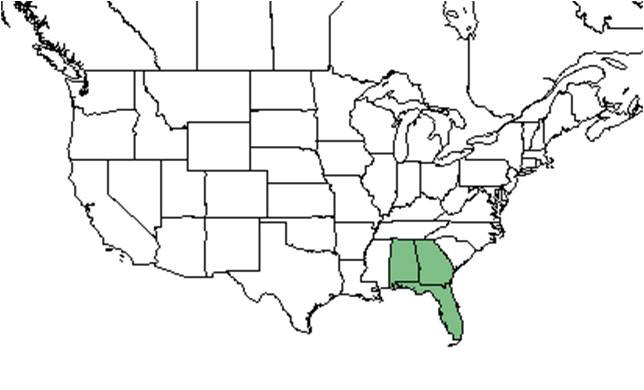Difference between revisions of "Eryngium aromaticum"
KatieMccoy (talk | contribs) |
KatieMccoy (talk | contribs) |
||
| Line 19: | Line 19: | ||
Common name: Fragrant eryngo | Common name: Fragrant eryngo | ||
| − | ==Taxonomic notes== | + | <!--==Taxonomic notes==--> |
==Description== | ==Description== | ||
<!-- Basic life history facts such as annual/perrenial, monoecious/dioecious, root morphology, seed type, etc. --> | <!-- Basic life history facts such as annual/perrenial, monoecious/dioecious, root morphology, seed type, etc. --> | ||
| Line 33: | Line 33: | ||
===Phenology=== <!--Timing off flowering, fruiting, seed dispersal, and environmental triggers. Cite PanFlora website if appropriate: http://www.gilnelson.com/PanFlora/ --> | ===Phenology=== <!--Timing off flowering, fruiting, seed dispersal, and environmental triggers. Cite PanFlora website if appropriate: http://www.gilnelson.com/PanFlora/ --> | ||
It produces thistle-shaped flowers arranged in umbels and achene fruit<ref name="Hortipedia"/>. | It produces thistle-shaped flowers arranged in umbels and achene fruit<ref name="Hortipedia"/>. | ||
| − | + | <!--===Seed dispersal===--> | |
| − | ===Seed dispersal=== | + | <!--===Seed bank and germination===--> |
| − | ===Seed bank and germination=== | + | <!--===Fire ecology===--> <!--Fire tolerance, fire dependence, adaptive fire responses--> |
| − | ===Fire ecology=== <!--Fire tolerance, fire dependence, adaptive fire responses--> | ||
===Pollination=== | ===Pollination=== | ||
The following Hymenoptera families and species were observed visiting flowers of ''Eryngium aromaticum'' at Archbold Biological Station (Deyrup 2015): | The following Hymenoptera families and species were observed visiting flowers of ''Eryngium aromaticum'' at Archbold Biological Station (Deyrup 2015): | ||
| Line 48: | Line 47: | ||
===Use by animals=== <!--Herbivory, granivory, insect hosting, etc.--> | ===Use by animals=== <!--Herbivory, granivory, insect hosting, etc.--> | ||
Used as larval food by the Eastern black swallowtail butterfly<ref name="Native"/>. | Used as larval food by the Eastern black swallowtail butterfly<ref name="Native"/>. | ||
| − | + | <!--===Diseases and parasites===--> | |
| − | ===Diseases and parasites=== | + | <!--==Conservation and Management==--> |
| − | ==Conservation and Management== | + | <!--==Cultivation and restoration==--> |
| − | ==Cultivation and restoration== | ||
==Photo Gallery== | ==Photo Gallery== | ||
==References and notes== | ==References and notes== | ||
Deyrup, M.A. and N.D. 2015. Database of observations of Hymenoptera visitations to flowers of plants on Archbold Biological Station, Florida, USA. | Deyrup, M.A. and N.D. 2015. Database of observations of Hymenoptera visitations to flowers of plants on Archbold Biological Station, Florida, USA. | ||
Revision as of 19:21, 19 January 2016
| Eryngium aromaticum | |
|---|---|

| |
| Scientific classification | |
| Kingdom: | Plantae |
| Division: | Magnoliophyta - Flowering plants |
| Class: | Magnoliopsida - Dicotyledons |
| Order: | Apiales |
| Family: | Apiaceae ⁄ Umbelliferae |
| Genus: | Eryngium |
| Species: | E. aromaticum |
| Binomial name | |
| Eryngium aromaticum Baldw. | |

| |
| Natural range of Eryngium aromaticum from USDA NRCS Plants Database. | |
Common name: Fragrant eryngo
Contents
Description
E. aromaticum is a low growing, perennial herb that can be found as a basal rosette of slightly spiny, deeply dissected leaves through out most of the year. It has a carrot like taproot[1]. Leaves are simple and alternate[2].
Distribution
It is found throughout the peninsula and panhandle of Florida, along with parts of Georgia and Alabama[1].
Ecology
Habitat
It can be found in well drained upland habitats[1].
Phenology
It produces thistle-shaped flowers arranged in umbels and achene fruit[2].
Pollination
The following Hymenoptera families and species were observed visiting flowers of Eryngium aromaticum at Archbold Biological Station (Deyrup 2015):
Halictidae: Lasioglossum placidensis
Sphecidae: Tachysphex similis
Vespidae: Stenodynerus fundatiformis
Use by animals
Used as larval food by the Eastern black swallowtail butterfly[1].
Photo Gallery
References and notes
Deyrup, M.A. and N.D. 2015. Database of observations of Hymenoptera visitations to flowers of plants on Archbold Biological Station, Florida, USA.
- ↑ 1.0 1.1 1.2 1.3 [Native Florida Wildflowers]Accessed: December 7, 2015
- ↑ 2.0 2.1 [Hortipedia]Accessed: December 7, 2015